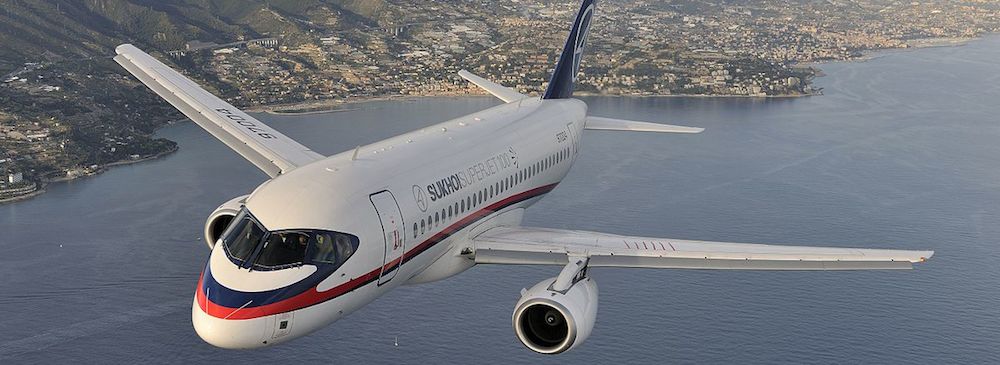Russia joins the race for Iran’s market with Sukhoi’s Superjet

A Russian-built Sukhoi Superjet 100 landed at Tehran’s Mehrabad International Airport in Iran on February 12, 2018, with a team of engineers on board. For the Russian plane manufacturer, this presentation is part of a renewed attempt to find customers in Iran for its passenger jet. For Iranian airlines, it is a considerable option after having difficulty in securing new aircraft from Western plane makers over the past two years.
In the initial wave of aircraft orders which followed the lifting of most international sanctions on Iran in January 2016, the country’s airlines placed $44 billion worth of business with Boeing and its main rival, Airbus. Smaller orders were also placed with the Airbus affiliate turboprop manufacturer ATR.
In February 2016, Iran Air signed a deal to buy up to 40 turboprop passenger planes from ATR. In December 2016, Airbus and Boeing agreed to sell a combined total of 180 jets to renew the aging fleet of Iran’s flag carrier.
Airbus agreed to sell 100 jets worth an estimated $27 billion, while Boeing committed to sell 80 planes valued at $16.6 billion, and possibly 30 more to another Iranian carrier, Aseman Airlines.
11 turboprops built by ATR had already been delivered in 2017, but the deliveries of larger jets from Airbus and Boeing are taking much longer. So far there had been just three Airbus jet deliveries to date and none from Boeing, Forbes writes.
What’s the hold up?
In January 2018, Airbus sales chief John Leahy predicted Iran would take delivery of dozens of European made jets it has ordered under a nuclear sanctions deal, but warned the transactions could take longer to complete than initially planned.
Leahy told Reuters: “I think those deals will get fulfilled, maybe not on the original schedule. We have to arrange financing; they have to understand about making pre-delivery payments.”
He indicated that Airbus would be cautious about building jets for Iran without receiving deposit payments. Industry sources also said that Boeing also held off manufacturing jets until it receives down payments.
Airbus has secured export licenses from the U.S. Treasury that expire by 2020. It would need renewed permission to complete its planned deliveries to Iran, which are scheduled to stretch beyond 2020. The number of deliveries covered by those existing licenses would shrink if schedules were delayed, Reuters reports.
Financial hurdles
The slow progress in renewing Iran’s aging fleets of passenger jets is a direct result of the U.S. sanctions. Deals need to be cleared by the U.S. Treasury’s Office of Foreign Assets Control (OFAC) before they can progress.
Arranging financing for the jets has been a significant hurdle as most major international banks are reluctant to do business with Iran fearing that the nuclear deal could unravel or they could fall foul of ongoing U.S. financial controls, Forbes writes.
U.S. President Donald Trump has strongly criticized the 2015 deal to lift a heap of sanctions in return for restrictions on Iran’s nuclear activities, and has threatened to pull the U.S. out of the deal.
In January 2018, the President waived sanctions against Iran as required under the nuclear agreement, keeping U.S. in the deal for now, but began four-month countdown until it ceases to comply with obligations under the agreement, The Guardian reported.
Thus, Iran Air, the country’s largest airline, may have to turn to domestic banks to finance the plane orders. Some Iranian carriers looked to secure financing deals through international leasing firms to support the purchases, but it is not clear if those efforts have succeeded.
Back in December 2017, Iran Air spokeswoman Massoumeh Asqarzadeh told local media in Iran that “Our preference is to use domestic financial resources, but we also have the option to finance the purchases through Airbus and Boeing themselves.”
In January 2018, Reuters reported industry sources saying that due to the lack of financing, Iran has indeed been forced to pay cash via its central bank for the airplanes it has received already, and that deals may be worked out allowing these payments to double as deposits for future jet deliveries.
Sukhoi’s Superjet-100: an option for Iran
Airbus and Boeing depend on the U.S. support for the nuclear deal because of the number of U.S. components in all their jets. On the other hand, Iranian officials say that deals to buy the Sukhoi aircraft will not need the U.S.’s OFAC approval as the modifications that the Russian manufacturer made to its Superjet-100 has less than 10 percent of U.S. components.
Speaking to the Iranian news agency Tasnim, the secretary of the Association of Iranian Airlines Maqsoud Asadi Samani described Super-100 as a suitable option for Iran. He also remarked that Sukhoi’s presentation of the jet was part of the company’s efforts to catch up with Western plane manufacturers for a share of Iran’s market.
Back in July 2017, the Iranian news agency Fars reported that Russia and Iran signed a contract on deliveries of several SSJ100 jets during the MAKS-2017 air show in Moscow, Russia. But the Russian Sukhoi Civil Aircraft company, manufacturer of Sukhoi Superjet 100, officially refuted such media reports.
The SSJ100 jet, which made its maiden flight in May 2008, is a twin-engine 100-seat airliner worth up to $25 million. It would not be a replacement for the larger jets already on order from Airbus and Boeing, but it may be a useful alternative for short-range domestic or regional services. It would also send a message to Western companies that Iran is considering all options.
Source – AeroTime

